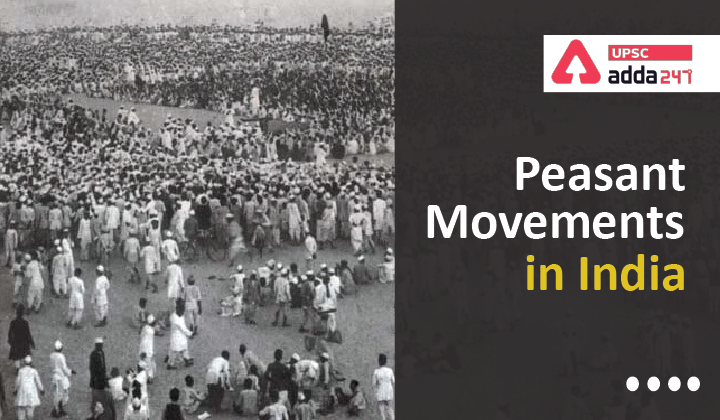| Peasant Movement |
Details |
| Indigo Revolt (1859-60) |
- Indigo growers’ revolt had flared up in Bengal in autumn of 1959
- It is also known as ‘Nil Bidroho’
- On the one hand, this revolt was directed against the indigo planters, on the other, it grew into a rent strike against the planter zamindars.
- This indigo revolt gave birth to a political movement and stimulated national sentiment against the British rulers among Indian masses.
|
| Rangpur Dhing (1783) |
- Rangpur uprising took place in Bengal
- It is called the first tough peasant rebellion against the East India Company rule.
- Diwani right to britishers in 1765 and five year settlement in 1767 led to exploitation of peasants.
- European collectors and Indian Ijardar (revenue farmer) worked in tandem to extort money from the cultivators.
- The rebellion spread over a significant area, including Ranchi, Hazaribagh, Palama.
- After two years of strong confrontation, they lost to modern weapons of the British.
|
| Kol Rebellion (1832) |
- Kol tribesmen of Chhota Nagpur were upset over exploitation by agents of the East India Company
- The Kols and other tribes enjoyed independence underneath their chiefs but the British entry threatened their independence.
- Handover of tribal lands and the encroachment of moneylenders, merchants and British laws created tension in the region.
- Leaders: Buddhu Bhagat, Joa Bhagat, Madara Mahato and others.
|
| Mappila Rebellion in Malabar (1841-1920) |
· Mappila or moplah name is given to Malayali-speaking Muslims who resided in the Malabar Coast of northern Kerala.
· The rebellion started as a resistance against both the British colonial rule in Malabar region and the landlords who were mainly Hindus.
- The revolt goes fell into the trap of Hindu-Muslim riot.
- During this period, Khilafat movement was raised (During Non-Cooperation movement for the fulfilment of freedom for Muslims.
- Read more about Moplah rebellion here.
|
| Santhal Rebellion (1855) |
- It was a native rebellion in present-day Jharkhand.
- This revolution was not only against the British Raj but also against the zamindars.
- The Santhals were evicted from their own land due to failure to pay taxes and debts.
- It was planned by four brothers -Sidhu, Kahnu, Chand and Bhairav
- The rebellion was suppressed and was over-shadowed by the other rebellions.
|
| Deccan Uprising (1875) |
- Ryotwari Settlement was the revenue system introduced in the Bombay Deccan region.
- The ryots of Deccan region of western India suffered heavy taxation under the Ryotwari system.
- The peasants found themselves trapped in a vicious network with the moneylender as the exploiter and the main beneficiary.
- The conditions had worsened due to a crash in cotton prices after the end of the American civil war in 1864, the Government’s decision to raise the land revenue by 50% in 1867, and a succession of bad harvests.
- This uprising also involved a social boycott of the moneylender.
|
| Munda Ulgulan (1899- 1900) |
- Birsa Munda led this movement in Ranchi.
- The Ulgulan, called the ‘Great Tumult,’ strived to ascertain Munda Raj and independence.
- The land agreements of the British were demolishing the tribal conventional land system.
- As a result of this rebellion, the government enacted the Chotanagpur Tenancy Act 1908.
- Traditional characters and language were used to arouse folk, exhorting them to demolish “Ravana” (dikus/outsiders and the British government )
|
| The Pagal Panthis |
- The revolt was led by Karam Shah
- It was guided by religious medicants called Pagal Panthis. At the initial stage it was directed against the zamindars and later assumed the character of an anti-British movement.
- Karim Shah taught that God created mankind. So, they are all equal and brethren to each other.
- The followers of Karim Shah, therefore, addressed each other as ‘Bhai-Saheb’. Their behaviour and way of life seemed unusual and peculiar to the people living in the plains.
- Bhai-Sahebs thus came to be called ‘Pagals’ (mad-caps) by the people in the plains.
|
| Faraizi Revolt |
- Led by Hazi Shariatullah and his son Dadu Mian
- Shariutullah vowed to bring the Bengal Muslims to the true path of Islam.
- Haji Shariatullah regarded British rule in Bengal as injurious to the religious life of the Muslims so, he wanted to expel the English intruders from Bengal
|
| Tebhaga Movement (1946–47) |
- The Tebhaga movement was organised mainly by the communist cadres of the bengal provincial krishak sabha.
- Tebhaga Movement was the sharecroppers’ movement demanding two thirds of the produce from land for themselves and one third for the landlords (so the word tebhaga).
- The resisting tenants added a new slogan to their agenda: the total abolition of zamindari system.
- The Partition of Bengal and the promises of the new government led to the suspension of the movement.
|
| Telangana Movement (1946-52) |
- This was the biggest peasant guerrilla war of modern Indian history affecting 3000 villages and 3 million populations.
- The princely state of Hyderabad under Asajahi Nizams was marked by issues like lack of civil and political liberties, forced exploitation etc.
- The autocratic-feudal regime of India’s biggest princely state was shaken up.
- The movement cleared the way for the formation of Andhra Pradesh on linguistic lines and realising another aim of the national movement in this region.
|




 TSPSC Group 1 Question Paper 2024, Downl...
TSPSC Group 1 Question Paper 2024, Downl...
 TSPSC Group 1 Answer key 2024 Out, Downl...
TSPSC Group 1 Answer key 2024 Out, Downl...
 UPSC Prelims 2024 Question Paper, Downlo...
UPSC Prelims 2024 Question Paper, Downlo...





